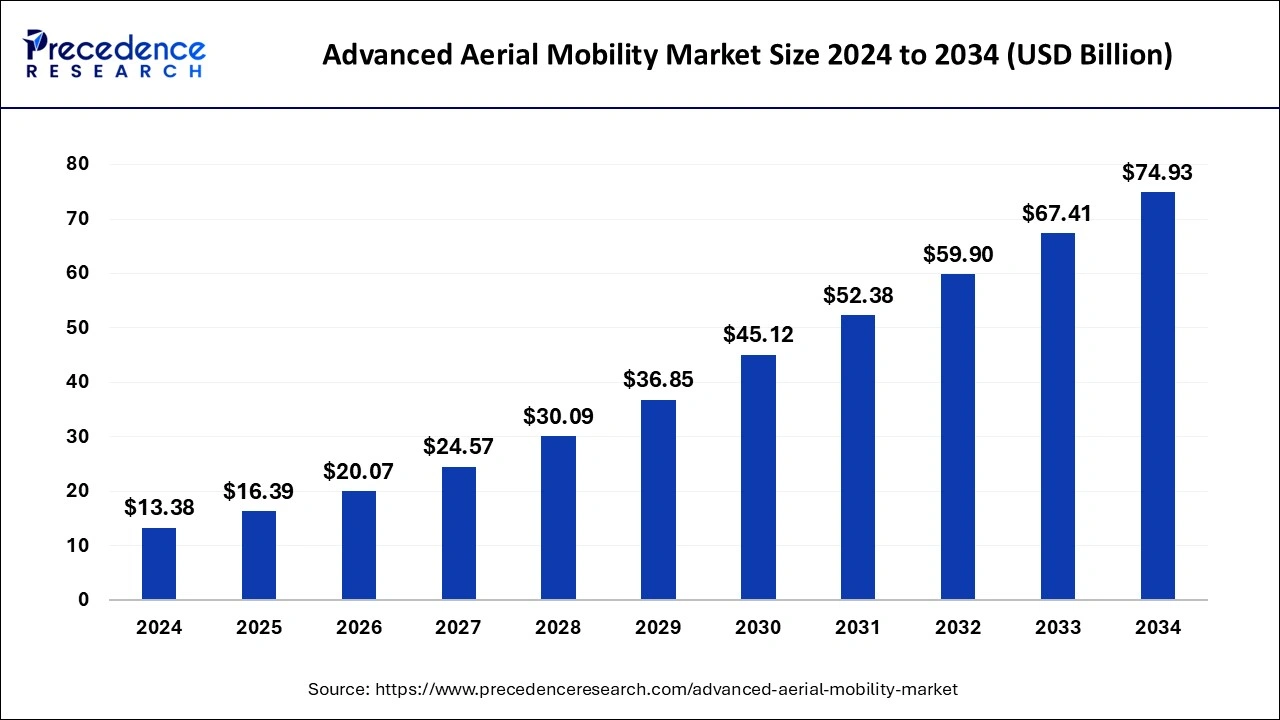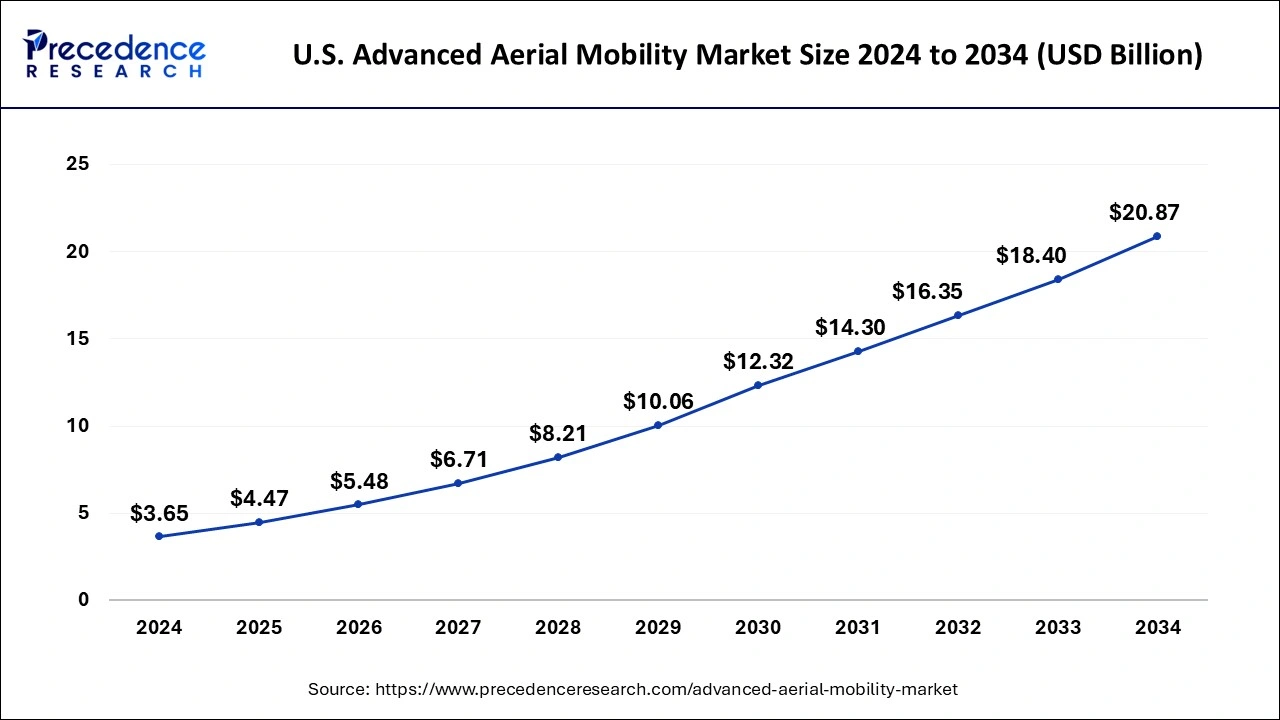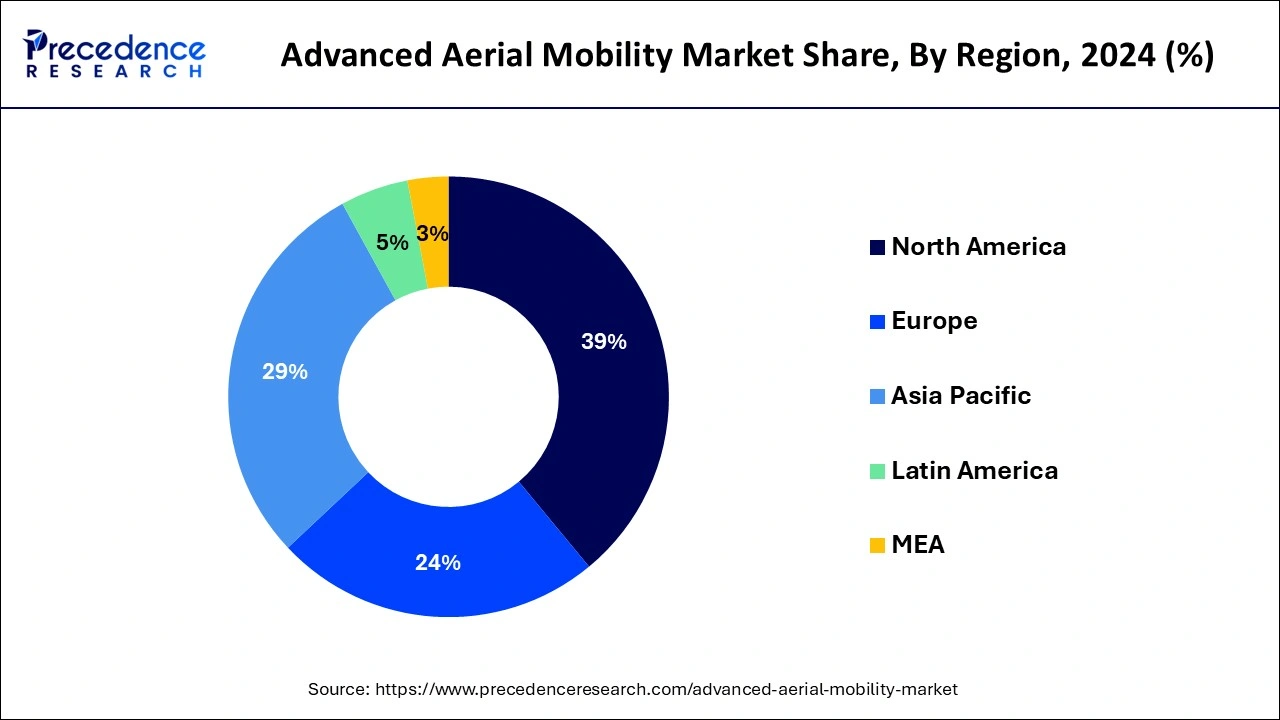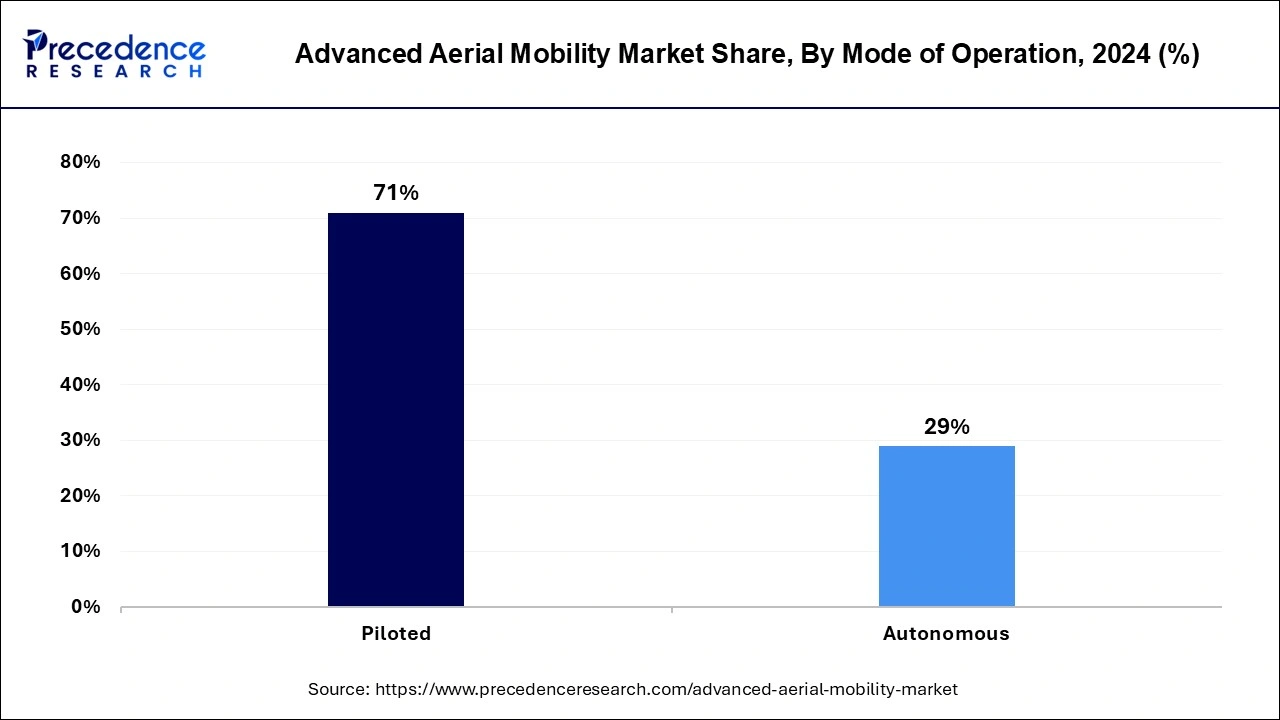January 2025
The global advanced aerial mobility market size is calculated at USD 16.39 billion in 2025 and is forecasted to reach around USD 74.93 billion by 2034, accelerating at a CAGR of 18.80% from 2025 to 2034. The North America advanced aerial mobility market size surpassed USD 5.22 billion in 2024 and is expanding at a CAGR of 18.95% during the forecast period. The market sizing and forecasts are revenue-based (USD Million/Billion), with 2024 as the base year.
The global advanced aerial mobility market size was accounted for USD 13.38 billion in 2024 and is anticipated to reach around USD 74.93 billion by 2034, growing at a CAGR of 18.80% from 2025 to 2034.

The U.S. advanced aerial mobility market size was evaluated at USD 3.65 billion in 2024 and is predicted to be worth around USD 20.87 billion by 2034, rising at a CAGR of 19.05% from 2025 to 2034.

During the projection timeframe, North America is anticipated to account for the biggest market position for sophisticated aerial transportation globally. The acceptance of expense aviation in both urban and rural settings, as well as the development of disruptive aviation technologies to move individuals and goods are driving the market's expansion in this area.

On the contrary hand, the Asia-Pacific region is anticipated to grow more quickly and provide a wealth of prospects for market expansion. Drone advanced technologies and an increase in the utilization of aircraft transportation for business purposes are among the reasons driving the market's expansion in this area.
To move individuals and goods in developing aircraft marketplaces, increasing air mobility aids in the development of secure, affordable air transportation networks. Enhanced aerial mobility will enable operators to do quiet, dependable, and secure vertical flights. Air transportation, which refers to a specific type of vehicle that can function on both the ground and the air depending on the situation, is regarded as a recent advance in urban transportation.
Unmanned systems are poised to become the next generation of transportation infrastructure thanks to recent technical advancements, which will alter the transportation industry's view in the nourish term. Improved aerial transportation has been significantly hampered by the COVID-19 pandemic's unexpected increase. Because of lockdowns and other limitations, the spreading of coronavirus in wealthy nations like the United States and the UK was anticipated to harm facilities for research and development for enhanced aerial transportation. Enhanced aerial movement remains in its early stages, and it is nearly difficult to foresee how COVID-19 infections will be controlled.
Leading market participants, meanwhile, are concentrating on strategic cooperation to begin testing and certification as quickly as possible. Considering the effects of the epidemic, the participants in the sophisticated airborne movement arena have demonstrated their capacity to adapt and develop in challenging circumstances. The next-generation commuting option is the flying automobile, which can serve as private transportation and a means of air travel.
Furthermore, because of operational and architectural constraints in the urban commuting system, the plurality of self-driving cars is anticipated to include vertically launching and landing technologies. Flying cars were anticipated to be employed on both a personal and professional level to accommodate shifting commuting needs, particularly in urban regions. In comparison to other forms of transport, flying vehicles and commercial drones have higher testing and development expenses since they call for the fusion of numerous advanced technologies.
The market for enhanced aerial transportation is expanding quickly on a global scale. One of the main factors driving the international industry's expansion is the increase in end-user demands for time-efficient courier companies and an expanding urban transportation perspective. The implementation of automation and robotics, customer preference for digitally enhanced technology, and technology advances in aircraft all aid in the expansion of the enhanced aerial transportation market across the globe.
Furthermore, as a result of rising ecological problems and road congestion, rapid urbanization and industrialization call for affordable and effective different transportation alternatives. Policies and guidelines must be passed by policymakers to support urban commuting alternatives. As a result, there is a growing market for airborne transportation, which will be very helpful in many places. Postal and courier businesses are permitted to use aircraft to speed up courier services by aviation agencies all over the world.
The market is anticipated to grow as more people embrace drone-based, based delivery technologies, that increase efficiency, and cut costs. Customers are increasingly demanding superior aerial movement for this same delivery service within the e-commerce sector, and they are also prepared to pay more for same-day shipping. Furthermore, the president's strict licensing requirements for pilots are predicted to impede the industry's expansion for sophisticated aircraft transportation.
Additionally, it is anticipated that growing worries about cyber security issues associated with drone operations may restrain market expansion. In addition, updated government regulatory frameworks and important players' growing emphasis on seizing Asia Pacific's untapped talent are anticipated to present profitable growth prospects for the sophisticated aerial transportation industry.
| Report Coverage | Details |
| Market Size in 2025 | USD 16.39 Billion |
| Market Size by 2034 | USD 74.93 Billion |
| Growth Rate from 2025 to 2034 | CAGR of 18.80% |
| Largest Market | North America |
| Base Year | 2024 |
| Forecast Period | 2025 to 2034 |
| Segments Covered | Mode of Operation, End-Use, Propulsion Type, and Geography |
| Regions Covered | North America, Europe, Asia-Pacific, Latin America, and Middle East & Africa |
There is an increasing need for alternative modes of transportation, especially advanced mobility
By 2037, the International Air Transportation Association (IATA) predicts that there will be 8.4 billion people using aircraft worldwide. By 2050, the UN predicts that 68% of people would reside in urban settings. Numerous congestion & accessibility challenges brought on by the increasing number of vehicles in cities are increasing the demand for alternate forms of transportation. In this sense, aircraft like VTOLs, eVTOLs, and STOLs had proven to be strong competitors. to prevent traffic, certain eVTOL airplanes were best suited for short-haul flights over busy places. Given these advantages, it is anticipated that AAM demand in advanced mobility applications would rise in the upcoming years.
It is anticipated that the demand for flying cars would fuel growth
Advanced mobility, which primarily consists of fuel-powered cars, is transitioning to digitally high-end technologies, combined with only an increase in the use of environmental transportation solutions, to create the very next robust and environmentally friendly transport network. In addition, the growing urbanization trend necessitates the development of alternative transportation strategies to address current transportation problems like heavy traffic and rising air pollution. Market participants for fighter jet alternatives are concentrating on developing electric or hybrid-driven vehicles that may be used on land and in the air. As a result, there is a growing desire for airborne automobiles, which will help to relieve road congestion. Self-driving cars are a reality and are currently being developed on a global scale on both a personal and professional level. During the projected period, the world market for enhanced airborne transportation is anticipated to develop as the need for hovering automobiles increases.
Growing environmental issues

More than multiple of the customer base is expected to be held by the piloted category in 2034, and it is anticipated that this share will remain dominant throughout the forecast timeframe. The automated segment is projected to exhibit the highest CAGR in the upcoming years, though.
Approximately 2/3 of the worldwide industry for sophisticated aerial transportation is predicted to be contributed by the cargo segment by 2030, and it is anticipated that this segment will continue to hold the top spot throughout the projected timeframe. However, it is anticipated that in the upcoming years, the passenger segment would increase at the highest CAGR.
By Mode of Operation
By End-Use
By Propulsion Type
By Geography
For inquiries regarding discounts, bulk purchases, or customization requests, please contact us at sales@precedenceresearch.com
No cookie-cutter, only authentic analysis – take the 1st step to become a Precedence Research client
January 2025
August 2024
November 2024
September 2024